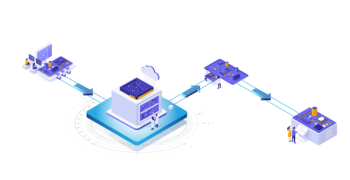Often referred to as microchips or integrated circuits (ICs), semiconductors are one of the greatest marvels of modern technology. Today, over 100 billion semiconductors are used around the world every day.
In this four-part, multi-author blog series, we will embark on a journey to understand more about this seminal technology, its present successes, and the future possibilities for unprecedented progress.
Semiconductors have not only made modern gadgets a reality, but constant advancements in the industry have made these devices smaller, cheaper, more powerful, and easily accessible to the public. For instance, in 1984, cellular phones weighed almost 2lbs., were priced at 4,000 USD, and could only hold a charge sufficient for talking for 30 minutes at a stretch. Today’s smartphones, including foldables, have taken a gigantic leap in terms of design and communication capabilities since then.
Semiconductors will play a key role in future technological advancements, as they are the foundation of technologies like 5G, AI, digital manufacturing, and medical technology. By 2025, the number of IoT (Internet of Things) devices installed worldwide will likely surpass 74 billion. By 2030, this number is projected to reach 125 billion. The more abundant these devices become, the more semiconductor technology becomes prevalent which, at this point, is a foregone conclusion.
It is no surprise that the semiconductor industry is projected to witness immense growth in the near future. A Gartner report expects the industry to grow by 7.4% in 2022 worldwide. Another report by McKinsey predicts that the industry will witness constant growth throughout this decade and emerge as a trillion-dollar industry in 2030.
Semiconductor processing operates on mainly four verticals, namely:
- Very Large-Scale Software Integration (VLSI)
- System Design
- Platform Software
- Validation
In a nutshell, VLSI refers to the process through which millions of transistors are merged and integrated into a single semiconductor chip. Moving on, hardware system design comprises the process of designing compact, agile, and energy-efficient ICs to cater to market demand. When we talk about platform software as a component, we specifically mean an innovative platform software solution. Such a solution needs to enable semiconductor companies to manufacture superior quality products with a high degree of design success with more competitive pricing. Finally, validation is the vertical in which a semiconductor chip is tested in a lab setup to validate different aspects of functional correctness.
In this first part of the series, VLSI takes the spotlight.
Very large-scale integration is the technology that allows an IC designer to incorporate many peripherals like CPU, RAM, and ROM into a single chip. It is the process of developing an IC by combining millions of transistors into a solitary chip.
The technology first came to the forefront in the 1970s, when communication technologies and complex semiconductors were first being developed. With time, electronic devices have become increasingly handy, portable, and accessible, and the incredible development in this industry over the last five decades can be credited to advancements in VLSI technology. Simply put, VLSI can be regarded as the backbone of the semiconductor industry.
Presently, cellular communications, and devices like smartphones, leverage this technology to provide unmatched portability, application access, and processing capabilities. Portable electronic appliances like laptops, smartphones, and devices using automated applications like refrigerators, air conditioners, and washing machines, are a few of the real-time applications of VLSI. VLSI circuits are used in all electronic equipment, for example, microprocessors in a computer, chips in a digital camera or graphic card, and embedded processors in automobiles.
The key advantages offered by VLSI technology are:
- Unparalleled reduction in circuit size
- Enhanced cost-effectiveness for gadgets
- Faster circuit operating speed
- Lower power requirements than distinct components
- High device dependability
- Less requirement of space and promotion of miniaturization
L&T Technology Services (LTTS) has developed several cutting-edge intellectual property in the VLSI space that address some of the key requirements of the semiconductor industry today. Our VLSI designs in areas like 3D cameras, speech recognition, smart glasses, and open network connectivity are helping drive the semiconductor journey across previously unexplored avenues.
With over 2,000 chip engineers around the globe and futuristic R&D infrastructure, LTTS is engineering next-generation products for multiple applications in industries ranging from Medical and Automotive to Telecom and Consumer Electronics.
LTTS’ holistic semiconductor offerings include system libraries and stacks, Linux kernel and device driver development, hardware abstraction engines, and a hardware platform. The VLSI vertical specializing in design, pre-silicon verification, DFX/physical design, field programmable gate array (FPGA) design, and pre- and post-silicon validation, is led by a team consisting of over 650 engineers. The vertical provides turnkey, frontend, and backend design services, with a retention rate of 80%.
As part of a major engagement, LTTS helped one of its valued customers achieve its outcomes through its VLSI expertise.
The semiconductor industry is at the forefront of ushering in the greatest era of technological advancement. It has systemically revolutionized communication, entertainment, travel, work, and the treatment of illnesses, to name just a few key areas of our lives. With semiconductors projected to transform entire industries, from medicine and energy to consumer electronics and aerospace, we are yet to experience its full potential. Through constant innovation, the semiconductor industry will continue to steer economic growth, create employment, and develop technologies required to build a future of limitless possibilities.
Check out Part II of our blog series on semiconductors, where we explore System Design, here.


